Happy Holidays to All,
So where have you been the past 4 weeks?
I hope you have been on the upper HF bands enjoying the excellent conditions that Ol' Sol has provided us.
I will provide more detail in the next Blog, but will illustrate the affects of a more active Sun.
For the past four weeks since my last report, Solar Flux continued to increase.
For 2013 between 11/23 and 12/20 solar flux averaged 147.
For 2014 between 11/23 and 12/20 solar flux averaged 167!!!
20 points doesn't seem a lot, but when it comes to the MUF it will raise it 2 MHz. It means full coverage to Europe on 10-Meters in the morning hours instead of a partial one.
 |
| Only during the ARRL 10- Meter Contest were 2014 Solar Flux levels below the same period in 2013. |
I am always amazed how well you can hear on 10-Meters. The following map is
my 10-Meter PSK31 captures for December:
 |
It is amazing what little it takes when Solar activity is high.
The captures mapped are my PSK31 captures for December minus 2 days using a RS HTX-10 and a 10M WB4BUM Hamstick mounted to the house bracket for my tower.
The 2 days missing I was operating QRP CW during the ARRL 10-Meter Contest in which I leisurely completed 106 QSOs in 48 multipliers. |
Total Activity Between 2013 & 2014
Compared to the same period in 2013, PropNet and non-PropNet captures increased 37% in 2014.
.png) |
| Each week during this period was better in 2014. |
 |
| The major difference was a significant increase in activity from mid-morning until mid-afternoon. |
It was interesting how the rise in Solar Flux affected the volumes hour by hour. The trend shown in 2013 is typical in solar active years. This year was the first time to see a mid-morning peak followed by a steady decline into the evening hours.
Distance
Since the trends had changed and volume increased, I though it would be interesting to find out where the distances laid.
Hour to Hour in Ranges
Please note the each UTC hour charted is actually one less
(1 UTC displayed is actually 0 UTC)
In the haste to complete these,
I failed to set the x-axis starting at 0.
Colors on column are consecutive 4 weeks measured.
300 - 1,250 Kilometer Range
This was the only range in which 2014 volumes failed to exceed 2013 volumes.
The range is similar to what is experienced during the Spring/Summer Es season.
Typically, morning activity is assisted by higher solar flux levels, while late afternoon/evening activity ends to be pure Es propagation.
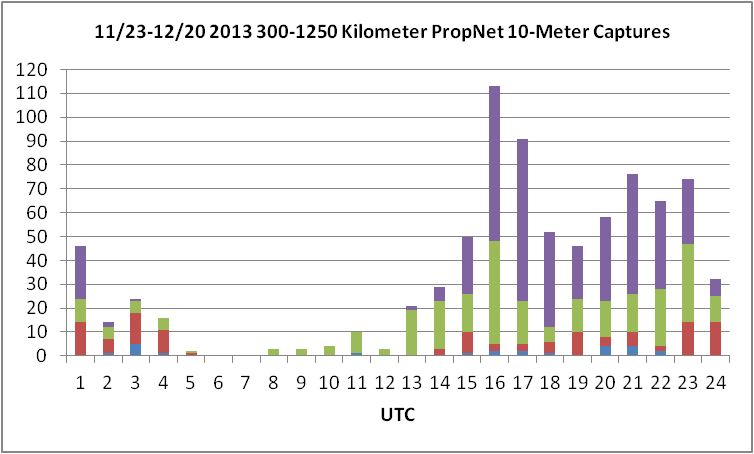 |
| In 2013 activity at this range is common during years of higher Solar Flux. |
 |
The surprise this year has been the significant lack of activity.
We have seen the higher Solar activity affect Spring/Summer Es but not Winter. |
Addendum:
First good Winter Es event started about 01:30 UTC 12/24. About time.
1,250 - 2,500 Kilometer Range
For this range you begin to see the positive affects of higher Solar activity.
This range represents typical single hop F2 propagation at the higher HF range. The shorter distances would be Florida to New England and the longer would represent East Coast to the Rocky Mountain states.
 |
| In 2013, the trends are a reflection of the position of the Sun. At 1800 UTC (19), the Sun is in the middle of North America. |
 |
| In higher solar flux levels, activity rises quickly then slowly declines as the sun moves westward. |
2,500 - 3,750 Kilometer Range
For this range you see the positive affects of higher Solar activity on the morning hours.
This range represents more extended single hop F2 propagation or possibly some double hop at the higher HF range. The shorter distances would be the West Coast to the Mississippi Valley and the longer would represent East Coast to the West Coast.
 |
| The chart represents how the visibility of sun is the dominant force affecting propagation. |
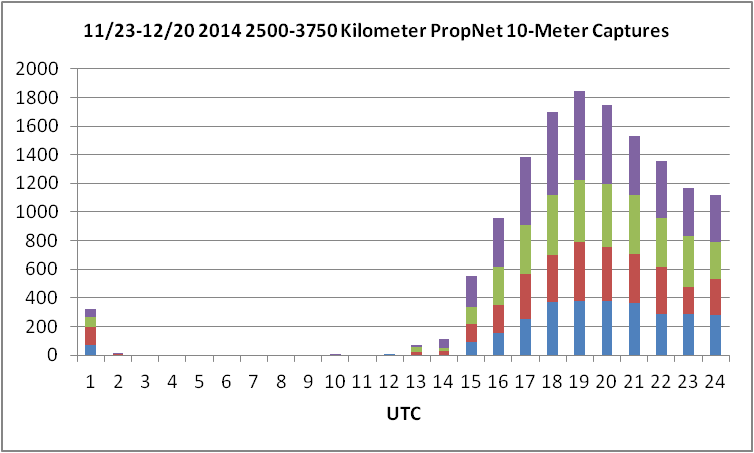 |
| Increase solar flux, the peak activity period sharply increases after sunup and is its highest when the sun is centered on the North American continent. |
3,750 - 5,000 Kilometer Range
For this range you see the greatest positive affect of higher Solar activity.
This range represents double hop F2 propagation or possibly some chordal skip affects in the higher HF range. The shorter distances would represent diagonal East Coast to the West Coast (California to Quebec) and the longer are paths towards the Caribbean islands.
 |
Once it becomes November, the opportunities for Trans-Equatorial lessens.
Most of the volume is diagonal (SW-NE, NW-SE) and TE. |
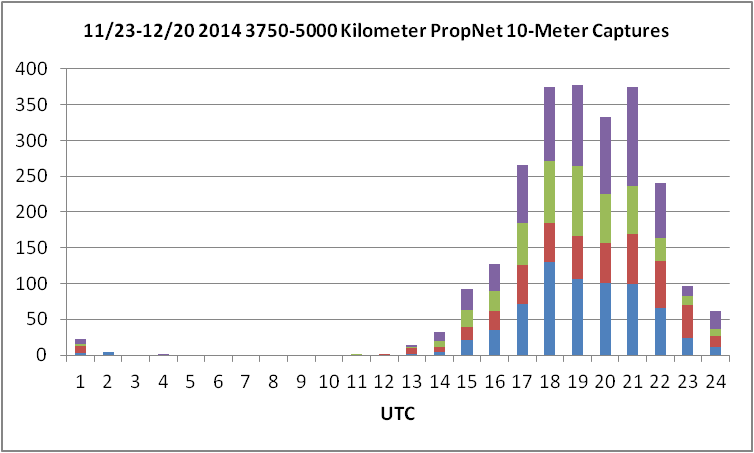 |
Given higher solar activity, a visible sun provides much more opportunity.
This segment had the greatest growth. TE was copied from sunup to sundown. |
5,000 - 6,250 Kilometer Range
For this range you see only a small positive affect of higher Solar activity.
This range represents multiple hop F2 propagation in the higher HF range. The distance range is predominately East Coast to Europe.
 |
| This segment is almost totally Trans-Atlantic. |
 |
Higher solar activity only had a minor improvement.
It was fairly automatic for the East Coast each day. |
6,250 plus Kilometer Range
For this range it was better results in the morning hours and less activity in the afternoon.
This range represents multiple hop F2 propagation in the higher HF range. The distance range is predominately Midwest, Mississippi Valley and East Coast into Europe, Trans-Equatorial and paths to Asia and Oceania. The farthest captures were from W5LA into Indonesia and N7YG into South Africa.
 |
| This range shows a distinctive dual diurnal peak, mornings to Europe and afternoons to the Far East and Oceania. |
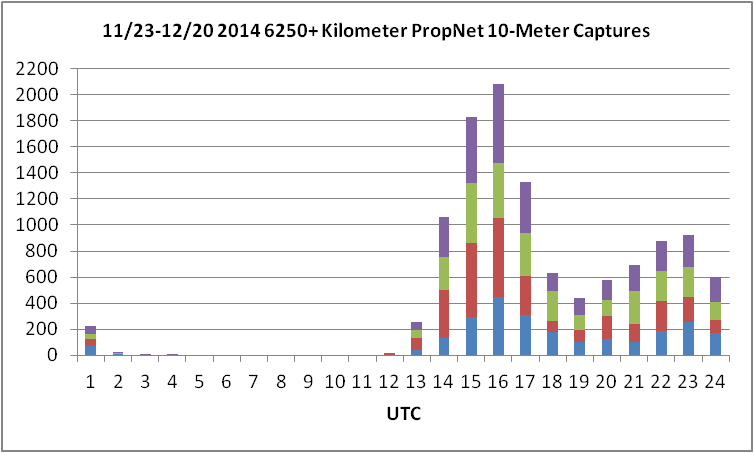 |
| This year we saw moderate gains in the morning towards Europe, but less activity to the East. Possibly intercontinental propagation is affecting it. |
Recap
These 4 weeks show that it is all about the level of Solar Flux. For 21 of the 28 days measured this period Solar Flux was well above 150. In 2013 only half of the days were. Production was noticably better.
Cycle 24 continues to be productive.
73s
Art Jackson KA5DWI/7

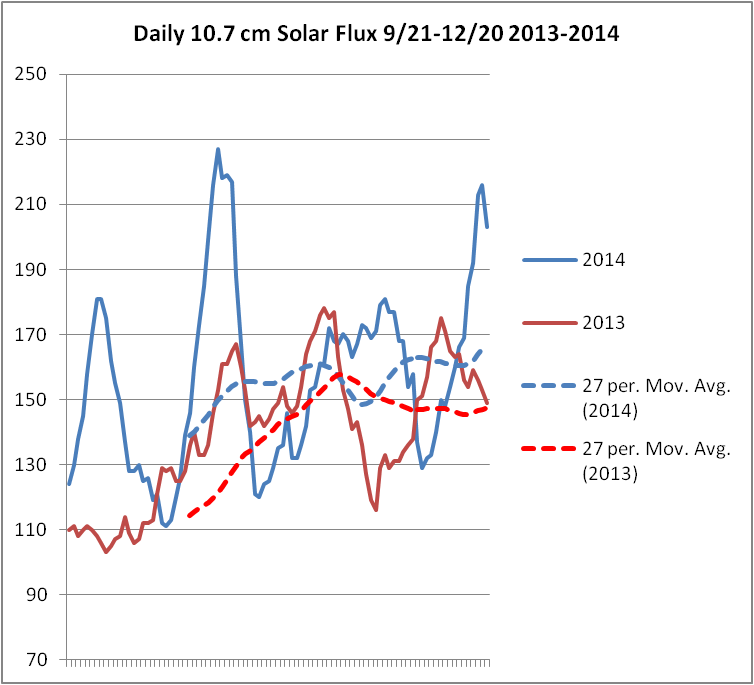
.png)





.png)














.png)
.png)
.png)
.png)
.png)
.png)






.gif)

.gif)
.gif)







